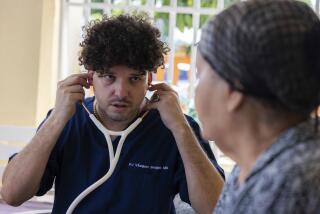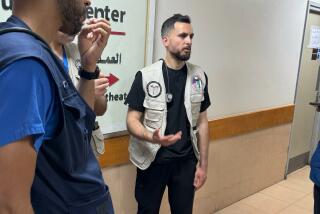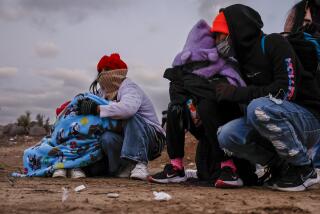A Refugee Among Refugees, a Doctor Puts Life on Hold to Help
- Share via
MOROLICA, Honduras — Keilyn Rodriguez was on the brink of achieving her dream. After struggling through medical school, the young mother was putting the finishing touches on a clinic in this riverside town of 5,000, planning to become the first resident doctor.
Then came tropical storm Mitch.
As terrified townspeople fled, thundering flood waters swept over the town. Today, it is a moonscape, with only the church steeple poking up from sun-bleached sand.
But one institution survives: Rodriguez.
Three miles from Morolica, the young doctor now attends the town residents, housed in bright blue tents outside a small village. Working from a schoolhouse, on call at all hours, Rodriguez sacrifices sleep and her own family to cure a devastated community.
Her work reflects the struggle of thousands of doctors, local and foreign, trying to prevent a health emergency in Central America.
“At the beginning, the future looked black. There wasn’t any medicine at all,” said the doctor, a slender 25-year-old with sleek hair tucked in a bun.
Now, thanks to the United Nations, aid groups and the Health Ministry, Rodriguez has antibiotics, a refrigerator with vaccines and chlorine to clean up dirty drinking water.
Yet her worries continue. About 200 families are sharing 14 crude latrines, a possible source of a cholera outbreak. Rodriguez still has no thread to sew up wounds.
Most urgently, several women are about to give birth. With roads washed out by the tropical storm, the closest hospital is five hours away, near the capital, Tegucigalpa.
“I need equipment to help the baby breathe,” said Rodriguez, pantomiming the suctioning of fluid from an infant’s throat. “If we don’t have this, the child could asphyxiate.”
Rodriguez managed to control the severe diarrhea that threatened the lives of children after the storm. Now she mainly treats less serious illnesses--strep throat, conjunctivitis and parasites.
However, as people get over the initial shock of the tragedy, other ailments set in. There is, for example, a wave of depression.
“People don’t sleep, they’re crying all the time, they’re worried about the future. What will happen to them?” Rodriguez said.
Like other doctors thrust into the middle of the tragedy, Rodriguez has had her own moments of despair. She fled Morolica with her parents, husband and 9-month-old daughter, Jovanna.
Hungry and skinny from diarrhea, the baby constantly cried in the early days of the disaster. Meanwhile, Rodriguez was besieged by 50, 60, 70 patients a day.
They needed her help. There was nobody else.
Finally, Rodriguez sent the baby away with her husband to his parents’ house in the north.
“She wanted my milk, but then someone would come and say, ‘You must see this patient!’ ” Rodriguez recalled, casting her eyes down at the memory.
“It hurt me to leave her,” she added softly, “but I couldn’t work.”
More to Read
Sign up for Essential California
The most important California stories and recommendations in your inbox every morning.
You may occasionally receive promotional content from the Los Angeles Times.













